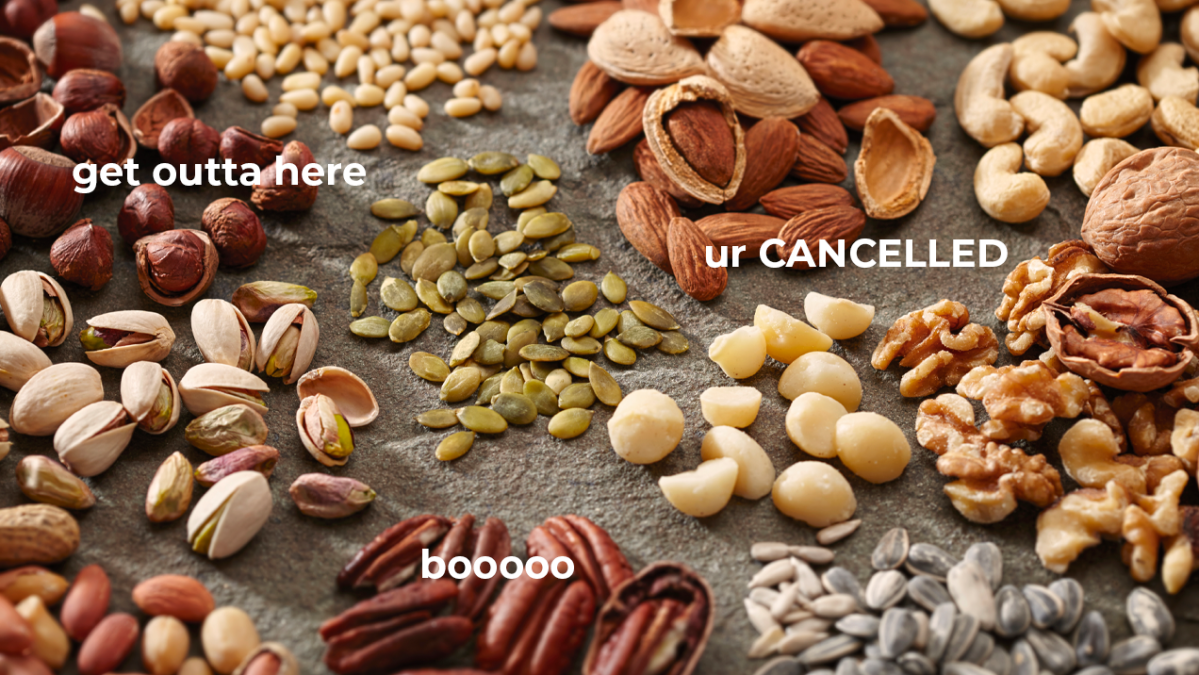
Look, we get it. We’re all trying to be environmentally conscious about what we eat. We all know not to buy foods containing palm oil because the plantations destroy rainforests, and we know to cut down on beef because of how of how much methane farms produce.
But did you know nuts – yes, as in almonds, pistachios, walnuts, etc. – are also terrible for the environment? Nuts are CANCELLED, baby.
It all stems back to just how goddamn thirsty these crops are. According to the Pacific Institute, nuts need almost 40 times the water need to grow, say tomatoes.
Obviously nobody’s going to bite into a tomato instead of cracking open some nuts, but the point is tomatoes are an essential vegetable whereas nuts are, well, a snack food. There are probably better uses of our water.

In fact right now, almond farms in the Murray-Darling Basin are struggling with water supply. Many farmers are worried there won’t be enough water to go around, and it’s in part because almond trees use up too much of it compared to other crops.
Last year, a Canadian pension fund bought up $490 million in water rights in the Murray-Darling to water almond trees. Thanks to almonds, our own drought is paying the pensions of retired Canadian soldiers.
The story gets even worse when you look at nuts imported from overseas.
According to the World Trade Atlas, the vast majority of Australia’s pistachios and walnuts come from California. While some are locally grown or imported from the Middle East, chances are, when you’re buying nuts at the supermarket, they’re from the Golden State.
California actually produces nuts for the whole world, despite being a dry state which spent most of the last decade enduring its worst drought in 1,200 years. That number isn’t a typo.

Yet nut farms somehow managed to stay perfectly lush, buying up water reserves for a thirsty crop when people didn’t even have enough water to drink.
Almond farms account for 10% of the state’s water use – more than any individual city. There’s even a single pistachio farm which uses more water than the whole of LA.
Why California? Because it’s one of the only climates in the world suitable for growing nuts. The only other major producer of nuts is Iran, where they were first cultivated, however due to sanctions, these are rarely exported to Australia, if at all.
Oh, did I just mention sanctions? That’s another reason why nuts are cancelled. In the US, the pistachio lobby has long pushed for tough sanctions on Iran, which disproportionately affected ordinary civilians and has made importing medical supplies during the coronavirus pandemic a huge hassle. That’s a story for another article.

Want to know more? Same. Here’s how you can educate yourself further.
Marc Fennell‘s new podcast Nut Jobs explores the cold case of an almond heist in California, but also looks at how morally bankrupt the industry is in terms of sustainability.
Meanwhile, an upcoming documentary, Pistachio Wars, explores the pistachio industry’s push for a war with Iran, but again, it also looks at how much the Californian nut farms disregard environmental stewardship responsibilities.
Of course, none of this is to say nuts aren’t delicious. I may or may not be eating a bowl of them right now. Here’s what we can to do be more conscious nut consumers:
Buy nuts which aren’t so harsh on the environment
Peanuts and cashews – two nuts which technically aren’t nuts – are much easier on the environment than almonds or pistachios. It takes 19 times less water to grow half a kilo of peanuts than it does to grow the same amount of pistachios.
Brazil nuts, meanwhile, can actually benefit the environment in some ways. Because they only grow well when surrounded by their natural, diverse ecosystem, harvesting Brazil nuts actually stops deforestation in the Amazon.
Hazelnuts are also a great choice because they’re so hardy. They don’t need a tonne of water or pesticides, and can be grown in really poor soil where other crops won’t grow. Hazelnut plants also help prevent unwanted soil erosion.
Try to buy locally
Buying nuts grown anywhere other than California is a step in the right direction. While there are some issues with almonds grown in the Murray-Darling basin, in general, Aussie-grown nuts won’t be as terrible for the environment.
Macadamia nuts are native to Australia and are almost entirely grown in NSW and Queensland. Because they’re being grown in their natural environment, they don’t need an ungodly (and unseasonable) amount of water to thrive. Also, they’re delicious.
Local nuts also don’t have to be shipped, quite literally, halfway around the world like Californian nuts do. This will do wonders for reducing our carbon footprint!
Make trail mix
There are so many things we can use to flesh out our nuts, so that we consume less.
By mixing them with, say, dried fruit chunks or mini pretzels, we can continue to nibble our hearts out.
It’s important to be conscious of what and how much we consume, and going easy on the nuts surely won’t be the end of the world.
Who doesn’t love trail mix?



